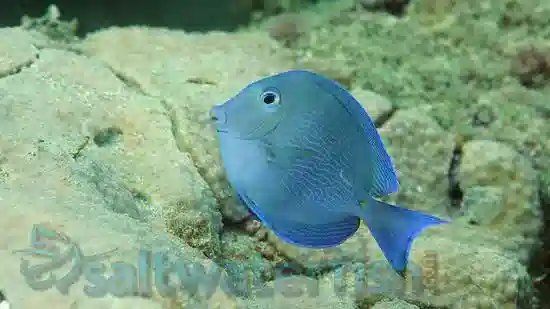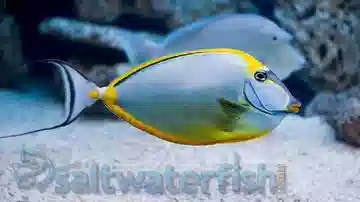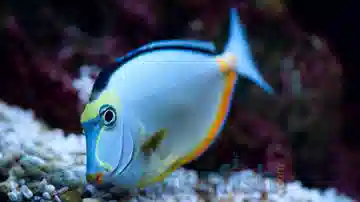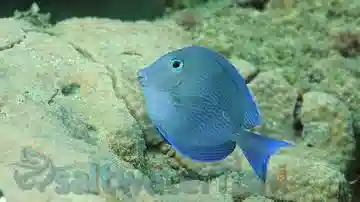Atlantic Blue Tang
Acanthurus coeruleus
(4 Reviews)

Atlantic Blue Tang
Acanthurus coeruleus
(4 Reviews)
{{ item.name }}
Size: {{ item.extra_field_3 }}
${{ getFormattedPrice(item.saleprice) }} ${{ getFormattedPrice(item.price) }}
To join the waiting list, click here
Free Shipping
With
$199.00
or more in Marine Life.
More details...
Atlantic Blue Tang Care Facts
| Care Level: | Moderate |
|---|---|
| Temperament: | Peaceful |
| Diet: | Omnivore |
| Reef Safe: | Yes |
| Minimum Tank Size: | 120 gallons |
| Max Size: | 15 inches |
The Atlantic Blue Tang is commonly referred to as the Blue tang, Blur tang, Blue tang surgeonfish, Blue doctor, Blue doctorfish, Yellow doctorfish, Blue barber, and Yellow barber. It prefers to live in holes and crevices to hide themselves from predatory species that is why the yellow juveniles are mostly found to be hidden and comes out rarely in the wild. The Atlantic Blue Tang is generally active during the day time and stays hidden during the night. It is known to set up cleaning stations where it has been observed removing parasites and molted skin from other species. It features spine on both sides of its caudal peduncle, which is used for protection and to establish dominance. At the juvenile stage, it displays a bright yellow color and that change into hues of blue during adolescence. Decorate the aquarium with plenty of live rocks and hiding spots, which allows it to carry out its natural scraping and sorting behavior. The Atlantic Blue Tang should not be housed with similar species, since it can turn aggressive.
Atlantic Blue Tang (Acanthurus coeruleus): A Practical Care Guide
The Atlantic Blue Tang, scientifically known as Acanthurus coeruleus, is a captivating marine species that can be an attractive addition to your saltwater marine aquarium. This straightforward guide will provide essential information on caring for this unique fish, including its habitat, compatibility, diet, care requirements, and more.
Habitat of the Atlantic Blue Tang
Atlantic Blue Tangs are native to the warm waters of the Western Atlantic Ocean, including the Gulf of Mexico and the Caribbean Sea. They prefer shallow coastal reefs and rocky formations, typically found at depths ranging from 3 to 65 feet (1 to 20 meters).
Reef Compatibility of the Atlantic Blue Tang
This species is generally considered reef-safe. Atlantic Blue Tangs primarily feed on algae, making them a valuable addition to reef aquariums, where they help control algae growth. However, they may occasionally nip at certain corals, mainly if their dietary needs are unmet.
Size and Lifespan of the Atlantic Blue Tang
Atlantic Blue Tangs typically grow to about 15 inches when fully mature. They can live for 5 to 7 years in captivity with proper care, providing several years of enjoyment for dedicated aquarists.
Diet in Captivity of the Atlantic Blue Tang
In their natural habitat, Atlantic Blue Tangs graze on various algae, detritus, and small invertebrates. In captivity, it's essential to replicate their natural grazing behavior. Provide them with high-quality marine algae sheets, seaweed, and a mix of marine pellets and frozen foods like brine shrimp and mysis shrimp.
Aquaculture and Availability of the Atlantic Blue Tang
Atlantic Blue Tangs are not commonly available through aquaculture. However, Saltwaterfish.com is dedicated to providing hobbyists with responsibly sourced fish, ensuring that each Atlantic Blue Tang is healthy, acclimated, and ready to thrive in your aquarium.
Compatibility with Other Fish and Invertebrates of the Atlantic Blue Tang
Atlantic Blue Tangs are considered peaceful and social fish. They can often coexist harmoniously with various tankmates, provided the tank is appropriately sized.
Sexual Dimorphism of the Atlantic Blue Tang
Sexual dimorphism in Atlantic Blue Tangs is minimal, making it challenging to distinguish males from females based on visual characteristics alone.
Temperament of the Atlantic Blue Tang
Atlantic Blue Tangs are known for their peaceful and social character. They are typically curious and active swimmers, making them a joy to watch in your aquarium.
Tank Requirements of the Atlantic Blue Tang
To provide the best care for your Atlantic Blue Tang, maintain a tank with a minimum size of 120 gallons. This ensures ample swimming space and helps reduce territorial conflicts. Water conditions should mimic their natural habitat, with a pH level between 8.1 and 8.4, a salinity level of 1.020-1.025, a stable temperature between 74-78°F (23-26°C), and moderate water flow to simulate ocean currents.
Common Names of the Atlantic Blue Tang
The Atlantic Blue Tang is also known by various names, including Blue Tang, Caribbean Blue Tang, and Blue Surgeonfish.
Compatible Tank Mates of the Atlantic Blue Tang
Here are five specific species that can make suitable tank mates for your Atlantic Blue Tang:
- Flame Angelfish (Centropyge loriculus)
- Royal Gramma (Gramma loreto)
- Lawnmower Blenny (Salarias fasciatus)
- Six-Line Wrasse (Pseudocheilinus hexataenia)
- Clownfish (Amphiprioninae)
Why Choose the Atlantic Blue Tang from Saltwaterfish.com
When you acquire an Atlantic Blue Tang from Saltwaterfish.com, you invest in a visually striking addition to your saltwater marine aquarium. Saltwaterfish.com is committed to responsibly sourced fish, ensuring that each Atlantic Blue Tang is healthy, acclimated, and ready to thrive in your aquarium. With their dedication to quality and a wealth of resources, Saltwaterfish.com makes it easy to enjoy the unique beauty of these tangs in your home aquarium.
In Conclusion
The Atlantic Blue Tang (Acanthurus coeruleus) offers a captivating social presence in saltwater marine aquariums. With their striking blue and yellow coloration, they can be a delightful choice for both beginner and experienced aquarists looking to add a touch of vibrancy to their collection. By adhering to their specific requirements and providing a suitable environment, aquarists can witness the Atlantic Blue Tang's presence in their aquatic habitat.
Perfect
Reviewed by: Scott Olson on Sept. 25, 2024
Very active fish enjoy watching.
Reviewed by: Brenda Girton on April 16, 2024
Both fish arrived happy and eating flake and prepared seaweed. They are active little swimmers and get along just fine.
Reviewed by: Rashon Hogan on Jan. 17, 2024
Reviewed by: Debbie Yasenka on Oct. 30, 2023















